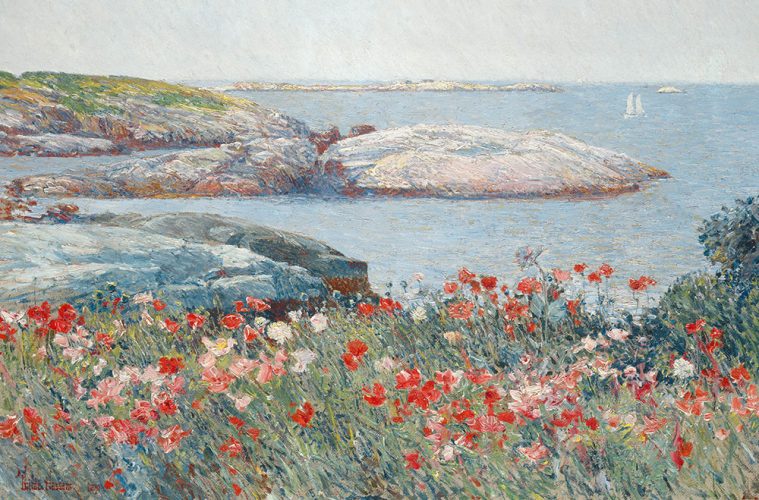On some level, enchantment with islands seems to be in our collective DNA. At least Romantics like to think so. For artist Childe Hassam (1859–1935), the Isles of Shoals—in particular, Appledore Island—located six miles off the New Hampshire and Maine coasts, were especially magical. Over the course of three decades, he returned to capture the beloved place with brushstrokes. This July, the Peabody Essex Museum (PEM), in conjunction with the North Carolina Museum of Art, presents 42 of Hassam’s oils and watercolors in an exhibition titled American Impressionist: Childe Hassam and the Isles of Shoals.
Austen Barron Bailly, PEM’s George Putnam Curator of American Art, says, “The show is about Hassam’s relationship to a place. It’s very exciting to think he found a place that allowed him to continue to explore his approaches to painting.”
Boston–born Frederick Childe Hassam first set foot on Appledore in 1882 as a young, self-trained illustrator and aspiring artist. Thirty years earlier, Nathaniel Hawthorne had been struck by the island’s’ rugged charms, yet even as a skilled wordsmith he found it “quite impossible to give the idea of these rocky shores.” Little is known about Hassam’s early visit except that it was the start of a long-lasting allure.
By the summer of 1886—Hassam’s first extended visit to the isles—Appledore was established as a social center for some of the best artists and literati of the time. It was there that he renewed a friendship with Celia Laighton Thaxter, whose family had operated a resort hotel for almost four decades. At one time, she had been Hassam’s art student in Boston. Though separated in age by 25 years, they were kindred spirits. He enjoyed her warmth and relished her aesthetic sense; she greatly admired and encouraged his work.
In her nearby cottage, Thaxter, a renowned poet, held salons, where Hassam enjoyed the chummy synergy found among creative types. He likened them to “one large family” composed of a “jolly, refined, interesting set of people.”
But a revolutionary painting style was vying for his attention, and off he went to Paris to study French Impressionism. For three years, he absorbed its tenets: accurate rendering of a momentary scene, plein air depiction, and the use of pure, bright colors and small brushstrokes. By the time he returned, he was adopting those ideas for his own work. The results were transformative.
Thaxter’s beloved cutting garden of “old fashioned flowers,” as she decribed it, arranged by height, not color, proved an ideal subject for Hassam’s series of “poppy” landscapes—five of which are part of the PEM show. Poppies in lush reds and pinks bloom among the brushstrokes. In watercolors, they appear airy and mellow, as if kissed by gentle ocean breezes. At Thaxter’s request, Hassam illustrated her last book of poetry, An Island Garden (1894), with color lithographs.
Thaxter died suddenly in 1894. Deeply bereft, Hassam took a five-year hiatus from the island, painting instead in Gloucester, Massachusetts, Havana, Europe, and Long Island, New York. Eventually, he returned to Appledore, spending every summer from 1899 until 1915, with the exception of 1910. (The Appledore House—renamed Appledore Hotel—and Thaxter’s cottage were destroyed by a great fire in 1914.)
In all, Hassam created nearly 300 works featuring Appledore Island in oils, watercolors, pastels, and colored pencil—about 10 percent of his life’s work. They are comparable to some of the best works by plein air French Impressionists.
Dramatic changes wrought by the Industrial Revolution had Hassam escaping to Appledore, a place he viewed as primeval, wild, and permanent. “The rocks and the sea are the few things that do not change,” he once wrote in a letter, “and they are wonderfully beautiful—more so than ever.”
It was there that he could turn his back on civilization, see things frankly, and view nature in full. “Art to me,” he wrote, “is the interpretation of impression which nature makes on the eye and brain. The word ‘impression’ as applied to art has been abused, and in the general acceptance of the term has become perverted. It really means the only truth because it means going straight to nature for inspiration. The true impression is realism.”
Bailly notes: “He imagined the place without people, even though the very pleasant amenities of the resort sustained him there.”
And, of course, the sea was omnipresent, as evidenced in the majority of his paintings.
In almost all of Hassam’s island works he established a very high horizon line, forcing attention to the middle and foreground—perhaps an affirmation of nature’s solidity. Rudimentary rock formations figure prominently in many of his scenes, and he draws out a spectrum of colors from a base gray. In his closely cropped views, sky hues are mutable, the sea seems to be forever changing, and rock anchors each canvas.
The show devotes a section of the gallery to a photo essay, “Appledore Today,” by Alexandra de Steiguer, a photographer and the winter caretaker (and sole occupant) of nearby Star Island.
Bailly, who spent three years assembling the show, urges visitors to make time for the exhibition. “You will see incredibly well-painted art of a beautiful place that really captures an artist’s love affair with an Atlantic island. It’s very inspiring.”
Peabody Essex Museum
161 Essex Street, Salem
978-745-9500

